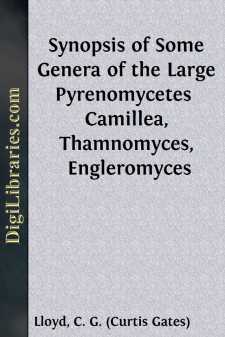Categories
- Antiques & Collectibles 13
- Architecture 36
- Art 48
- Bibles 22
- Biography & Autobiography 813
- Body, Mind & Spirit 142
- Business & Economics 28
- Children's Books 16
- Children's Fiction 13
- Computers 4
- Cooking 94
- Crafts & Hobbies 4
- Drama 346
- Education 46
- Family & Relationships 57
- Fiction 11829
- Games 19
- Gardening 17
- Health & Fitness 34
- History 1377
- House & Home 1
- Humor 147
- Juvenile Fiction 1873
- Juvenile Nonfiction 202
- Language Arts & Disciplines 88
- Law 16
- Literary Collections 686
- Literary Criticism 179
- Mathematics 13
- Medical 41
- Music 40
- Nature 179
- Non-Classifiable 1768
- Performing Arts 7
- Periodicals 1453
- Philosophy 64
- Photography 2
- Poetry 896
- Political Science 203
- Psychology 42
- Reference 154
- Religion 513
- Science 126
- Self-Help 84
- Social Science 81
- Sports & Recreation 34
- Study Aids 3
- Technology & Engineering 59
- Transportation 23
- Travel 463
- True Crime 29
Synopsis of Some Genera of the Large Pyrenomycetes Camillea, Thamnomyces, Engleromyces
Categories:
Description:
Excerpt
THE GENUS CAMILLEA.
The receipt of a nice specimen of Camillea Cyclops from Rev. Torrend, Brazil, has induced us to work over the similar species in our collection. On our last visit to Europe we photographed the various specimens we found in the museums, but did not study them as to structure. However, they make such characteristic photographs that we believe the known species can be determined from our figures.
We are all familiar with the common Hypoxylons that form little globose, black balls, usually on dead limbs, in our own woods. They have a solid carbonous interior with the perithecia imbedded near the surface. There have been over two hundred alleged Hypoxylons, mostly from the tropics. We have never worked them over, but suspect that a number of them from the tropics, when examined, will be found to be Camilleas. If the specimens were examined, no doubt "prior" specific names would be found for several of this list.
In the old days all similar carbonous fungi were called Sphaeria. Montagne first received a section of Sphaeria with cylindrical form, from South America. The perithecia were long, cylindrical, and were arranged in a circle or were contiguous, near the summit of the stroma. He proposed to call it Bacillaria, as a section of Sphaeria, but the name being preoccupied, he, at the suggestion of Fries, afterwards named it in honor of himself, Camillea, Montagne's first name being Camille.
The original species were separated into a genus by Montagne in 1855, and five species listed, and it is a curious fact that these five species, as well as all others that have since been added, are of the American tropics. I have not worked over the "Hypoxylons" in the museums, but as far as the records go the genus Camillea does not occur in other tropical countries.
In 1845 Léveillé announced that he had discovered a plant resembling an Hypoxylon which had, however, the spores borne on filaments (acrogenous), and not in perithecia. He called it Phylacia globosa, and classified it in Sphaerioidaea. The specimen (Fig. 847) is still at Paris. Saccardo has omitted it, and states that Phylacia is probably a pycnidial condition of Hypoxylon turbinatum. Both were guesses, one statement surely, and both probably, wrong. The interior is filled with a powder that under the microscope appears to be made up of ligneous filaments mixed with a few spores. These filaments appear to me to be the disintegrated walls of the perithecia, and not the "filaments that bear the spores." From analogy, at any rate, the spores of all these similar species are probably borne in asci which disappear early, and Phylacia seems to be the same genus as Camillea, the walls of the perlthecla disintegrating and forming a powdery mass. If this view is correct, Camillea can be divided into two sections.
EUCAMILLEA.—Perithecia persistent.
PHYLACIA.—Perithecia early disintegrated.
SECTION 1. EUCAMILLEA.
CAMILLEA LEPRIEURII (Fig. 826).—Carbonous, black, cylindrical, 2-3 cm. long, 3-4 mm. thick....


